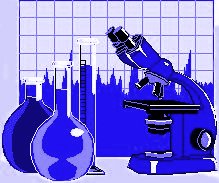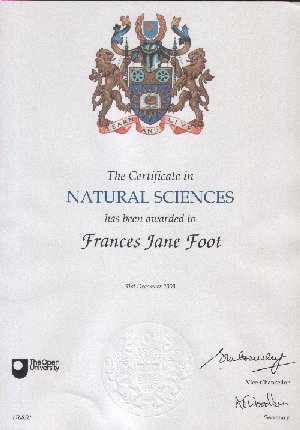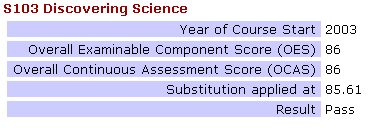
S103 Discovering Science
Starts 1st February 2003 (or, more accurately, November 2002)
My S103 Diary
Block 12 Life, the Universe and everything
Block 11 Boom! And then there was!
Block 10 Luverly stuff!
Block 9 Continuity & Change
Block 8 Atoms, bloody atoms
Block 7 Quantum Physics (first part)
Block 6 Beginners' alchemy
Block 5 Awful stuff (energy)
Block 4 Biology Block 3 - Earth, Stars and things
Block 2 and the rain gauge
Block 1 - In the beginning
Biology Glossary
Chemical Substances
OU S103 Course Description
S103 Website
Course Induction
New Scientist
ScienceNet
Nature: International Weekly Journal of Science
MadSci Libe
DiscoverySchool (maths help)
tcaep SI Units
From Quarks to Quazers
Scientific Notation
Seismic Monitor
Paleomaps
The Virtual Earth
Bill's S190 Page
UK Climate Impacts Programme
Climate Change
Hadley Centre for Climate Prediction and Research
JPL.NASA
The Nine Planets
Galileo: Journey to Jupiter
Beagle2
Hyper Physics
USGS This Dynamic Earth: Story of Plate Tectonics
ODSN Plate Tectonic Reconstruction Service
Volcanoes.com
NASA Earth Observatory
Cascade Range Volcanoes and Volcanics
Natural Environment Research Council
Cells Alive!
Wayne's Word
Biosis
English Nature
The Wildlife Trusts
UK Biodiversity
National Biodiversity Network
Biology Links (Harvard Uni)
Online Biology Book
Embryology
DNA animations
DOE Genomes.org
ATP Synthesis
Dihydrogen Monoxide Research
Chemistry Tutorials
Advanced Chemistry Devolopment (downloads)
Chemdex.org
General Chemistry Online
Reaction Tutor
A visual interpretation of the Periodic Table of Elements
Web Elements (more Period Table)
The Orbitron
The Periodic Table of Comic Books
Elementymology
Molecule of the Month
Molecules with Silly Names
Quantum Zone
Electron Arrangements
Back to OU
|
|||||||||||||||
I had registered for A211 - Philosophy and the Human Situation, for next year - but, because of the change in circumstances at home, I decided that there might be *too* much concentration and reading required for that course, so have changed it to this one. I really HAD to do it sometime anyway - and now I am very much looking forward to it (though am confused as to why nearly all the OU Routes links for the course are concerning aluminium!)
The first lot of course materials arrived on 20th November (which was seemingly odd for a course that didn't start until 1st February!) Further comments about this course can be found on my diary page.
The blocks:
Block 1 Water for life explores the nature and importance of water, on which all life depends. It also introduces the study, writing and mathematical skills that you will need and that are developed throughout the course.
Block 2 A temperate Earth? investigates global temperature changes, and the phenomenon of global warming as a consequence of both natural and human-induced activity.
Block 3 The Earth and its place in the Universe introduces the galaxies that comprise the Universe, and our solar system as a tiny speck in the Milky Way Galaxy, and then focuses on the Earth to examine its internal structure and dynamic behaviour.
Block 4 Unity within diversity looks at the nature of the life that inhabits the Earth's surface: the features that all life-forms have in common, how organisms are related to each other and how they differ.
Block 5 Energy considers the fundamental physical property that keeps you alive and active, keeps the sun shining and (literally) makes the world go round.
Block 6 Our world and its atoms explores the nature of atoms, the basic building blocks of all materials.
Block 7 The quantum world takes you inside the atom to learn about the even tinier particles of which the hundred or so known types of atom are made, and which help to determine their differences.
Block 8 Building with atoms looks at how atoms bond with each other in different combinations, through chemical reactions, to produce the enormous diversity of materials known to humankind, from fertilizers to polymers and pharmaceuticals.
Block 9 Continuity and change is about the chemistry of living organisms and the chemical processes that provide the energy to maintain life, moving on to consider how a blueprint for development is passed down from one generation of organisms to another (genetic theory). It also asks how changes within populations of organisms take place (evolution).
Block 10 Earth and life through time looks not only at how life has evolved since it began about 3,800 million years ago, but also how the pattern of continents and ocean basins and the rocks they are made of have evolved over geological time.
Block 11 Universal processes takes you beyond the Earth and the solar system once more, and back some 11000 million years to the moment when the Universe originated in a cosmological ‘big bang'; and we look at what happened in the first second of its existence.
Block 12 Life in the Universe Finally, we speculate on how and why life on Earth began and whether it is likely to exist anywhere else - a question that may very well be answered before the twenty-first century draws to a close.
TMA Marks
TMA01 - 92% (doesn't count towards assessment)
TMA02 - 81%
TMA03 - 80%
TMA04 - 80%
TMA05 - 94%
TMA06 - 92%
TMA07 - 81%
TMA08 - 87%
Coursework = 86%, using substitution, as below(?)
ECA score = 86%
So - HOORAY!!
The Open University Home Page
OU Student Home Page
OU Departments
Earth Sciences
Biological Sciences
Chemistry
Physics and Astronomy



